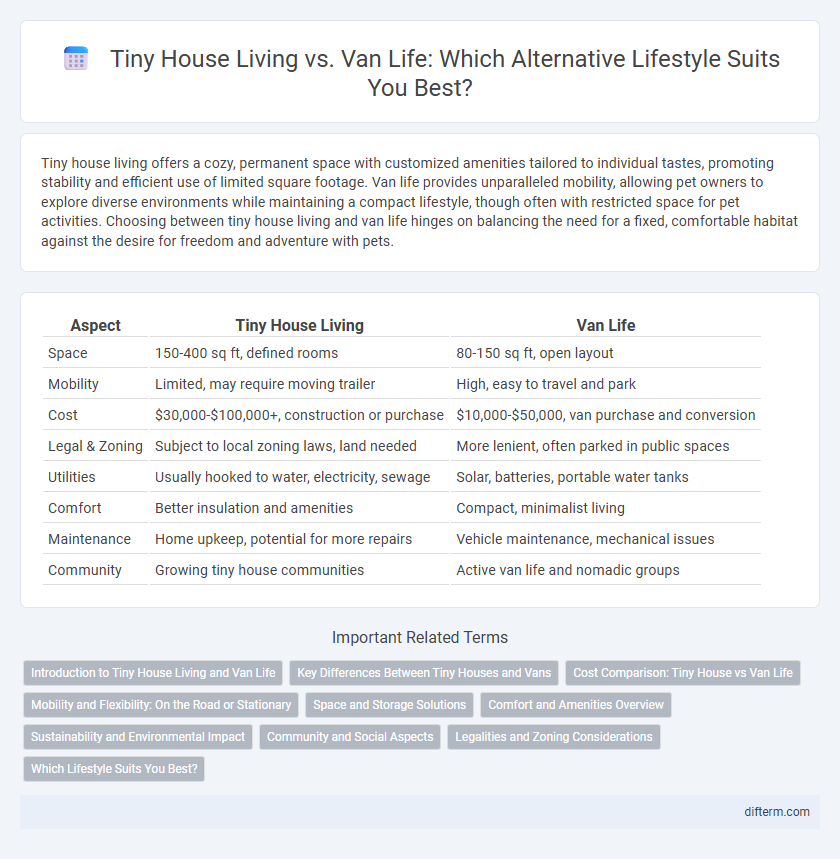Tiny house living offers a cozy, permanent space with customized amenities tailored to individual tastes, promoting stability and efficient use of limited square footage. Van life provides unparalleled mobility, allowing pet owners to explore diverse environments while maintaining a compact lifestyle, though often with restricted space for pet activities. Choosing between tiny house living and van life hinges on balancing the need for a fixed, comfortable habitat against the desire for freedom and adventure with pets.
Table of Comparison
| Aspect | Tiny House Living | Van Life |
|---|---|---|
| Space | 150-400 sq ft, defined rooms | 80-150 sq ft, open layout |
| Mobility | Limited, may require moving trailer | High, easy to travel and park |
| Cost | $30,000-$100,000+, construction or purchase | $10,000-$50,000, van purchase and conversion |
| Legal & Zoning | Subject to local zoning laws, land needed | More lenient, often parked in public spaces |
| Utilities | Usually hooked to water, electricity, sewage | Solar, batteries, portable water tanks |
| Comfort | Better insulation and amenities | Compact, minimalist living |
| Maintenance | Home upkeep, potential for more repairs | Vehicle maintenance, mechanical issues |
| Community | Growing tiny house communities | Active van life and nomadic groups |
Introduction to Tiny House Living and Van Life
Tiny house living offers a compact, stationary home solution designed for minimalism and sustainability, often featuring smart space utilization and eco-friendly materials. Van life emphasizes mobility, enabling individuals to travel freely while living in a converted vehicle equipped with essential amenities for on-the-go comfort. Both lifestyles prioritize simplicity and reduced environmental impact but cater to different preferences for stability versus adventure.
Key Differences Between Tiny Houses and Vans
Tiny house living offers spacious, permanent structures with full utilities and customizable interiors, whereas van life emphasizes mobility, compact design, and efficient use of limited space. Tiny houses typically provide enhanced comfort, insulation, and storage solutions, while vans prioritize versatility for travel and minimal setup time. Both lifestyles appeal to minimalism but cater to different needs regarding stability versus freedom on the road.
Cost Comparison: Tiny House vs Van Life
Tiny house living generally requires a higher upfront investment, averaging between $30,000 and $60,000, compared to van life costs which can range from $10,000 to $40,000 depending on conversion expenses. Ongoing costs for tiny houses include property taxes, insurance, and utilities, whereas van life involves fuel, maintenance, and occasional campsite fees. Both lifestyles offer economical alternatives to traditional housing, but van life typically presents lower overall expenses and greater financial flexibility.
Mobility and Flexibility: On the Road or Stationary
Tiny house living offers a stable, customizable home base with ample space, making it ideal for those valuing stationary comfort. Van life emphasizes ultimate mobility and spontaneity, allowing travelers to explore diverse locations without being tied down. Both lifestyles provide unique flexibility, with tiny houses delivering permanence and vans enabling constant movement on the road.
Space and Storage Solutions
Tiny house living offers structured storage solutions with built-in cabinets, lofted beds, and multi-functional furniture optimizing vertical space for organized belongings. Van life requires creative use of compact, modular storage units and under-bed compartments to maximize limited square footage while maintaining mobility. Both lifestyles emphasize efficient space utilization but differ in fixed versus flexible design approaches to accommodate varying needs.
Comfort and Amenities Overview
Tiny house living offers a fixed space with customized amenities like full kitchens, bathrooms, and climate control, enhancing comfort through stability and personalized design. Van life prioritizes mobility and compactness, featuring space-saving solutions such as fold-out beds and portable cooking equipment, which may limit comfort and permanent amenities. Choosing between the two depends on balancing the desire for home-like features against the appeal of travel freedom and minimalism.
Sustainability and Environmental Impact
Tiny house living typically results in lower energy consumption and reduced waste due to fixed, efficient design and smaller space, promoting sustainable resource use. Van life minimizes environmental impact through mobility, encouraging minimalism and lower material possessions, but often relies on fossil fuels for travel. Both lifestyles reduce carbon footprints significantly compared to traditional housing, with tiny houses favoring stationary energy efficiency and van life emphasizing low-consumption, mobile minimalist living.
Community and Social Aspects
Tiny house living fosters tight-knit neighborhoods with shared communal spaces and regular social events, creating a strong sense of belonging among residents. Van life encourages a more fluid, nomadic community where connections form spontaneously at meetups, campsites, and online platforms centered around travel. Both lifestyles emphasize meaningful social interactions but differ in the stability and location-based nature of their communities.
Legalities and Zoning Considerations
Living in tiny houses often faces restrictive zoning laws and building codes that limit placement to designated residential areas, while van life encounters fewer regulatory barriers due to vehicle classification but must comply with parking and camping regulations. Tiny houses may require permits and adherence to minimum dwelling sizes, complicating placement on private or rented land. Van life enthusiasts must navigate local ordinances on overnight parking and long-term stays, with some cities enforcing strict anti-camping laws.
Which Lifestyle Suits You Best?
Tiny house living offers a stable, customizable space ideal for those valuing a permanent address and community roots, while van life provides unparalleled mobility and freedom appealing to adventure seekers and minimalists. Assess your priorities such as work flexibility, social interaction, and travel frequency to determine which lifestyle aligns with your personal goals. Consider factors like budget, legal regulations, and maintenance to choose the best fit for sustainable and fulfilling living.
Tiny House Living vs Van Life Infographic

 difterm.com
difterm.com